Nose Surgery in New York City
(Rhinoplasty)
Rhinoplasty, or cosmetic nasal surgery, is one of the most commonly performed plastic surgery procedures performed in the United States. Rhinoplasty ranks consistently in the top five commonly performed cosmetic surgical procedures of all ages, ethnicities, and in both men and women. Dr. Sachin Shridharani offers rhinoplasty nose surgery to his patients in the New York City metro area.
Schedule a Consultation Today!
What Is Rhinoplasty?
A rhinoplasty, also known as nose surgery or a “nose job,” is a plastic surgery procedure commonly performed to correct the structure, function, and aesthetics of the nose. Rhinoplasty enhances facial harmony and leaves the nose size more balanced in relation to the face. This can be accomplished by improving the nose width at the bridge, the position, and size of the nostrils, the profile of the nose, the tip of the nose, or any asymmetry.
Am I a Good Candidate for Nose Surgery?
If you are unhappy with the cosmetic appearance or the functionality of your nose, you may be a good candidate for rhinoplasty. In order to be considered an ideal nose surgery candidate, you must be:
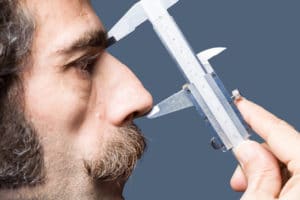
- In general good health
- A non-smoker
- At least 13 years of age
- Realistic about the outcome of surgery
Dr. Shridharani will perform a thorough examination during your consultation to ensure you are a good candidate for this procedure.
Benefits of Rhinoplasty
The main goal of rhinoplasty is to improve facial appearance. However, there are many other goals and benefits associated with nose surgery. Benefits include:
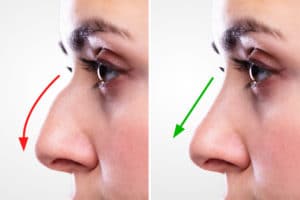
- Repairing nose after an injury
- Changing the size of your nose
- Reshaping tip of the nose
- Reshaping and resizing nostrils
- Removing a bump on the nose
- Altering the shape or size of the bridge
- Improving the ability to breathe
If you believe you can benefit from any of the above, you may want to consider undergoing a New York City rhinoplasty.
How does nose surgery work?
These are delicate procedures demanding both surgical expertise and a creative eye, as there are different options for each patient. That’s where Dr. Shridharani’s extensive experience and board-certified training come into play for our patients. Dr. Shridharani performs many revision rhinoplasties for patients who are unsatisfied with surgery done elsewhere.
These procedures can be done working from outside or inside. The extent of change desired by the patient will dictate the method used. With open rhinoplasty, Dr. Shridharani makes an incision across the columella, the tissue between the nostrils. He then lifts up the soft tissues of the nose to expose the underlying bone and cartilage beneath. The open method allows the best access to those structures to shave off bumps or otherwise reshape the bone and cartilage. If the patient desires that an area be built up, additional cartilage or other material is needed. Dr. Shridharani can take this from the septum, ears, and ribs, or he can use Silastic implants. When a nose needs to be made smaller, it’s necessary to break the nasal bones.
Breathing problems are usually addressed by working with the septum and the inner structures to open the airways.
Watch Dr. Shridharani Perform a Rhinoplasty
What can I expect the day of the surgery?
Dr. Shridharani will address everything you need to do before coming to the surgery center. This is not a “set” procedure, meaning there are many variables based on the patient’s individual needs. The two of you will decide whether local anesthesia with sedation or general anesthesia is the way to go.
As discussed in the procedure section above, this surgery may be performed using the open method through an incision at the columella between your nostrils or closed with all the incisions made inside the nose.
After your surgery, you’ll be in bed with your head raised to reduce bleeding and swelling. There will likely be internal dressings that will stay in your nose for one to seven days. Dr. Shridharani will also tape a splint to your nose for protection and support. Slight bleeding and drainage of mucus and old blood are common for a few days after the surgery.
You’ll need to avoid any strenuous activity for several weeks, so as not to raise the blood pressure to your face. You can’t blow your nose, and it’s best to take baths rather than showers while you still have bandages on your nose. Wear only clothes that button to avoid pulling clothes over your head and hitting your nose.
Patient Testimonials
“Dr. Shridharani is absolutely amazing!! So incredibly knowledgeable and kind to his patients! They will answer any and all questions and are extremely thoughtful and professional. Love love loves them!!! The absolute best doctor and staff in plastic surgery!”
– Katarina M“Finding Dr. Shridharani was truly a blessing in disguise. He is so incredibly knowledgeable about his surgeries, kind, patient, respectful, and funny. He answers all questions thoroughly and with honesty. His staff is truly amazing and caring. Despite how you try to reach out to the team (phone or email) they always respond in a timely manner.”
– Sariah R.P.
Click here to read more reviews.
Open Rhinoplasty Vs Closed Rhinoplasty
Rhinoplasty is performed either using a closed or open technique. During closed rhinoplasty incisions are hidden inside the nose. During an open rhinoplasty, the incision is made across the columella, the narrow strip of tissue that separates the nostrils. These incisions are necessary to gently raise the skin that covers the nasal bones and cartilages, allowing access to reshape the structure of the nose.
What Is a Non-Surgical Rhinoplasty?
Dermal fillers such as Juvederm, Restylane, or Belotero, for nasal contouring, have become increasingly common over the past several years. During a “non-surgical rhinoplasty” or a “liquid rhinoplasty” filler is used to inject into specific places to help correct minor contour irregularities that otherwise would require surgery. This is commonly done when patients are not ready for a rhinoplasty, which usually due to the downtime involved with surgery. If you have an important event coming up and are unhappy with your nose, but do not have the downtime for surgery, a “non-surgical rhinoplasty” may be the best option for you.
Also, some patients may find they are nervous about changing the defect they have had for so long, and starting with a “liquid rhinoplasty” may be more suiting for them. Results typically last 8-12 months depending on the filler that is used. If you are looking for more permanent results surgery is your best option. Having an in-depth discussion with Dr. Shridharani will help finalize a plan suited specifically for you.
Rhinoplasty Before and After
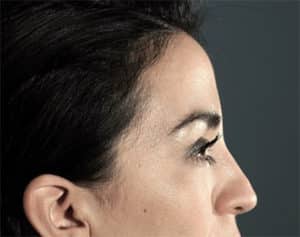

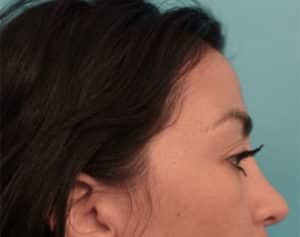

Click here to view more nose surgery before and after photos for Dr. Shridharani.
Can Nose Surgery Fix a Deviated Septum?
A deviated septum means the cartilage that separates the nostrils is misaligned which may cause partial airway obstruction. A deviated septum can be the result of many things that leads to difficulty breathing and sometimes a crooked appearing nose. Generally, a repair of the septum, also known as a septoplasty, is required to repair the internal structures that are not straight. A deviated septum is one of my most common causes of breathing impairment. Dr. Shridharani will carefully evaluate your nasal structure during your consultation to determine if your septum needs to be repaired.
Will My Nose Be Broken During Rhinoplasty?
During a rhinoplasty, it may be necessary to narrow the nose if the bony part of the nose seems too wide. Also, it may be necessary to fracture the nasal bones if you have a large “bump” on your profile view and you want it reduced. If only the tip of your nose bothers you, there is a chance you will not have to have your bones broken at all.
Rhinoplasty Recovery
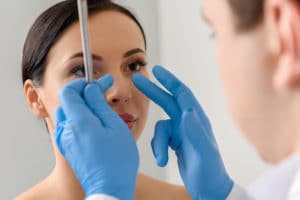
Generally, black eyes and swelling under the eyes are a result of the need to break the nasal bones during the rhinoplasty procedure. Darkening under the eyes usually dramatically improves several days after the procedure. Dr. Shridharani will review your surgical plan with you during your consultation.
Dr. Shridharani asks that his patients wear a splint for one week after surgery. Dr. Shridharani will remove your splint on your post-op office visit. The splint is important to keep the nasal structure in place while you are healing from your rhinoplasty.
When can I resume normal activities after a Rhinoplasty?
Following cosmetic nasal surgery, patients typically can resume normal activities, including work, within 7-10 days. Patients can use smartphones, tablets, computers the next day, i.e. work from home as soon as 24 hours. Strength training and intense exercise can commence at 4-6 weeks post-procedure.
Scarring After Nose Surgery
Anytime an incision is placed on the face/nose, a scar will result. The goal of an excellent plastic surgeon is to place as few incisions as possible in areas that are easily concealed. During your consultation, Dr. Shridharani will thoroughly review the location of your anticipated incisions.
When Will I See My Nose Surgery Results?
Initial swelling subsides within a few weeks. During this time you will notice a gradual improvement until your new nasal contour will be visible. These changes are generally appreciated within a few weeks. The final result of your cosmetic nasal surgery may take up to one year.
Is rhinoplasty safe?
Rhinoplasty is the most common facial plastic surgery. It is also one of the original plastic surgeries, the first documented rhinoplasty being performed in 1887. This is surgery, so it entails all of the risks inherent with that: excessive bleeding, reaction to anesthesia, infection, and the like. These are all very rare with nose surgery.
Specific to this procedure, there are risks of permanent numbness in and around your nose. Breathing difficulties can develop. The main risk is the patient won’t be satisfied with the changes in his or her nose.
Again, that’s where the experience and training of Dr. Shridharani benefit our patients.
Is rhinoplasty recovery painful?
Pain isn’t usually a problem during recovery; it’s more a question of swelling and bruising. Swelling is worst for the first week, but then it can come and go for months. Bruising is also common, but not painful. It simply is due to the tissue trauma caused by this procedure. Overall, Dr. Shridharani’s rhinoplasty patients tell us their pain was fairly mild after this surgery.
What are the risks involved with rhinoplasty?
This is major surgery, so it includes the usual risks of excessive bleeding, infection, poor wound healing, and possible reaction to anesthesia. Specific to rhinoplasty, these are the risks:

- Recurring nosebleeds
- Difficulty breathing through your nose
- Permanent numbness in and around your nose
- Possibility of an uneven-looking nose
- Pain, discoloration, or swelling that may persist
- Scarring
- Septal perforation
How much does rhinoplasty cost?
The cost of rhinoplasty with Dr. Shridharani can vary depending on your unique situation. If you need only minor changes that will entail an easier procedure than a fully open approach that could involve tissue grafting, repairing a deviated septum, and other variables. The best way to find out how much your surgery will cost is to schedule a consultation with Dr. Shridharani at Luxurgery. Once he examines your nose and understands the changes you’d like to make, he can then have a real idea of what’s necessary for your surgery. At that point, we can give you a precise cost for your rhinoplasty with us.
Of course, Dr. Shridharani performs many “revision” rhinoplasties that were done by other surgeons. Revisions can be necessary if a patient’s goal were not met or if the surgeon didn’t do a good job. This is why it’s important to do your research and only work with a board-certified plastic surgeon such as Dr. Shridharani. This isn’t an area where you should shop for a bargain-basement price, as it’s likely you’ll only be having another surgeon redoing your surgery later.
Is rhinoplasty covered by insurance?
If your nose surgery, whether rhinoplasty or septoplasty (to adjust the septum, the wall inside your nose that divides the nasal passages into a right and left side), is primarily intended to correct issues with function, then insurance is likely to cover the procedure. Of course, some cosmetic adjustments can be made at the same time as structural improvements.
Schedule a Consultation
Ready to learn more about Rhinoplasty and find out if you are a good candidate? Call (212) 508-0000 to schedule a consultation with board-certified NYC Plastic Surgeon, Dr. Shridharani.

